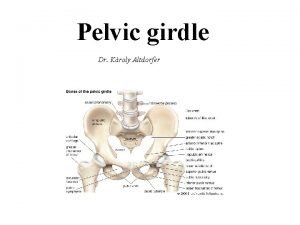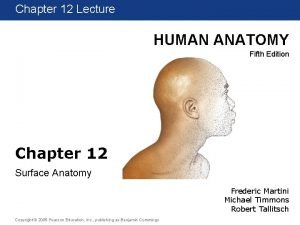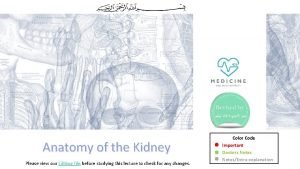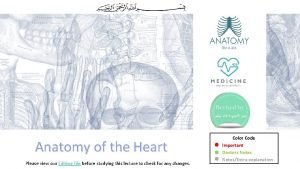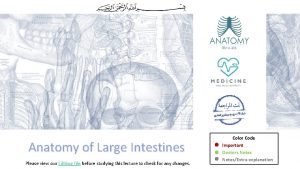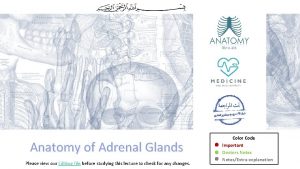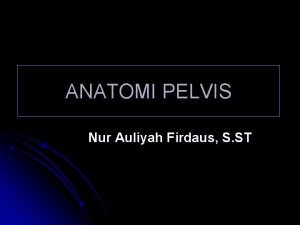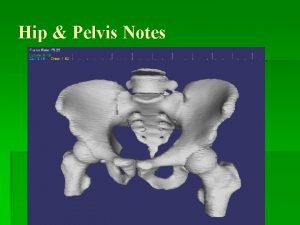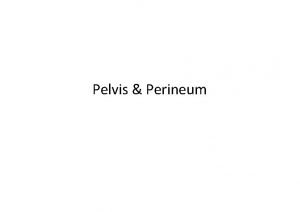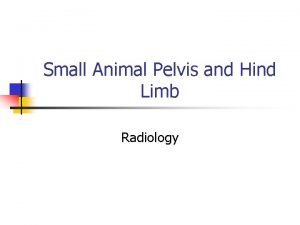Anatomy of the Pelvis Please view our Editing



























- Slides: 27

Anatomy of the Pelvis Please view our Editing File before studying this lecture to check for any changes. Color Code Important Doctors Notes/Extra explanation

Objectives At the end of the lecture, students should be able to: ü Describe the anatomy of the pelvic wall, bones, joints & muscles. ü Describe the boundaries and subdivisions of the pelvis. ü Differentiate the different types of the female pelvis. ü Describe the pelvic walls & floor. ü Describe the components & function of the pelvic diaphragm. ü List the arterial & nerve supply ü List the lymph & venous drainage of the pelvis. In males ﺍﻭ In females ﻧﻜﺘﺐ ﻟﻤﺎ : ﻣﻼﺣﻈﺔ ﺍﻟﺮﺟﺎﻝ ﺍﻭ ﺍﻟﻨﺴﺎﺀ ﺟﺴﻢ ﻓﻲ ﻓﻘﻂ ﻣﻮﺟﻮﺩ ﻧﻘﺼﺪ Boys’ slides ﺍﻭ Girls’ slides ﻛﺘﺒﻨﺎ ﺍﺫﺍ ﺑﻴﻨﻤﺎ ﻭﺍﻟﺪﻛﺘﻮﺭﺓ ﺍﻟﺪﻛﺘﻮﺭ ﺑﻴﻦ ﺍﻟﻤﺤﺎﺿﺮﺓ ﺳﻼﻳﺪﺯ ﻓﻲ ﺍﺧﺘﻼﻑ ﻧﻘﺼﺪ

Introduction o The bony pelvis is composed of four bones: • Two hip bones, which form the anterior and lateral walls. • Sacrum and coccyx, which form the posterior wall. The four joints are: o These 4 bones are connected by 4 joints and 2 - Two Sacroiliac joints. (Synovial joints) Posteriolateraly lined by 4 muscles. o The bony pelvis with its joints and muscles form a strong basin-shaped ( )ﺣﻮﺽ structure (with 3 - Sacrococcygeal joint multiple foramina), (2 ry Cartilaginous joint) o The pelvis contains and protects the: Posteriorly Between sacrum & coccyx (1) lower parts of the alimentary & (2) urinary tracts & 1 - Symphysis pubis (2 ry Cartilaginous joint) (3) internal organs of reproduction. Anteriorly

Pelvis The pelvis is divided into two parts by the pelvic brim or inlet: False or greater pelvis Above the brim (part of the abdominal cavity) Below the brim. Has 3 parts: True or lesser pelvis Bounded by: Posteriorly: Lumbar vertebrae. Laterally: Iliac fossae and the iliacus muscle. Anteriorly: Lower part of the anterior abdominal wall. 1. A Cavity: The cavity is a short, curved canal, with a shallow anterior wall and a deeper posterior wall. It lies between the inlet and the outlet. It supports the abdominal contents 2. Inlet (oval shape) 3. Outlet* (Diamond shape) Anteriorly: Symphysis pubis (upper border) Anteriorly: Symphysis pubis (lower border) Posteriorly: Promontory of sacrum, ala of sacrum. Posteriorly : Tip of Coccyx. Laterally: (both sides) Ileopectineal (arcuate) lines. Extra False pelvis Inlet True pelvis ﻳﻜﻮﻥ ﺑﺎﻟﺘﺮﺗﻴﺐ Outlet Perineum Pelvic brim Anterolaterally: ischiopubic ramus. Posterolaterally: (Ileo = illum pectineal = pubis) Sacrotuberous ligament & ischial tuberosities. *recall these are the same boundaries as the perineum

Pelvis Female vs. Male FEMALE Oval shaped Types of Female Bony Pelvis MALE Heart shaped What is the main differences between male and female pelvis? 1. In female the Sacrum is usually wider and shorter, while in male is long and curved. 2. Also, the Angle of the pubic arch is wider. 3. The promontory and the ischial spines are less projecting, while the male is inverted. o Information of the shape and dimensions of the female pelvis is of great importance for obstetrics. o Why? because it is the bony canal through which the child passes during birth. o There are 4 types: A. Android (resembles male pelvis) B. Gynecoid (typical female type) C. Anthropoid (has both male and female characteristics) D. Platypelloid (least common) **Gynecoid is the only type that can give normal birth , the other three types can’t.

Pelvic Walls Anterior 10: 26 Posterior The pelvis has 4 walls: lateral Inferior (floor) The walls are formed by bones and ligaments that are lined with muscles covered with fascia and parietal peritoneum. 1. Anterior pelvic wall It is the shallowest wall and is formed by only bones: (1) the posterior surfaces of the bodies of the pubic bones, (2) the 2 pubic rami, and (3) the symphysis pubis. 2. Posterior pelvic wall It is large and deeper. Formed by: (1) sacrum, (2) coccyx , (3) piriformis muscles (right and left) and (4) their covering of parietal pelvic fascia.

Pelvic Walls 3. Lateral pelvic wall It is formed by: 1. Part of the hip bone below the pelvic inlet (the arrow), 2. Obturator internus and its covering fascia, the obturator fascia. 3. Sacrotuberous ligament. 4. Sacrospinous ligament. 4. Inferior pelvic wall (floor) Basin-like structure which supports the pelvic viscera and is formed by the pelvic diaphragm. It stretches across the lower part of the true pelvis and divides it into: 1. Main (true) pelvic cavity above, which contains the pelvic viscera 2. Perineum below which carries the external genital organs.

Pelvic Walls Piriformis muscle (part of posterior pelvic wall) Obturator internus muscle (part of lateral pelvic wall) Origin Pelvic surface (in front of) the middle 3 sacral vertebrae. It leaves the pelvis through the greater sciatic foramen. Origin Inner surface of the obturator membrane and the hip bone. It leaves the pelvis through the lesser sciatic foramen Insertion Greater trochanter of the femur. Action Lateral rotator of the femur at the hip joint. Innervation Sacral plexus (lies in front of the muscles). Innervation Nerve to obturator internus (from sacral plexus).

Pelvic Diaphragm o It is formed by the levator ani and the coccygeus muscles and their covering fasciae. o It is incomplete anteriorly to allow passage of: • the urethra in males and • urethra and vagina in females. o Posteriorly the muscles of each side meet together.

Pelvic Diaphragm Levatores Ani Muscles 02: 54 • It is a wide thin sheet-like muscle that has a linear origin. • ORIGIN: (look at the dotted yellow line) 1. Back of the body of the pubis 2. Tendinous arch of the obturator fascia 3. Spine of the ischium (ischial spine). • Its fibers are divided into 3 parts: 1. Pubococcygeus 2. Puborectalis 3. Iliococcygeus (Ischiococcygeus) Extra

Levatores Ani Muscles Anterior Fibers 1. Pubococcygeus o Origin: originates from the posterior surface of the body of the pubis and passes downward & medially o Insertion: inserted into the perineal body, anococcygeal body and coccyx. o Action: • forms a sling around the prostate or the vagina*: In males Levator prostate: 1. Supports prostate 2. Stabilizes perineal body In females Sphincter vaginae: 1. Supports vagina 2. Stabilizes perineal body *While the muscle goes from origin to insertion it surrounds these 2 organs (prostate or vagina) and supports them. levator prostatae sphincter vaginae Pubococcygeus

Levatores Ani Muscles Intermediate Fibers 2. Puborectalis ( )ﺷﻜﻠﻬﺎ ﺯﻱ ﺍﻟﻠﺠﺎﻡ ﺑﺘﺎﻉ ﺍﻟﺨﻴﻞ • forms a sling around the recto-anal Junction. • It has a very important role in maintaining fecal continence. • Its tone is important to maintain the angle between rectum & anal canal. When it relaxes, the angle is gone and defecation can occur Posterior Fibers 3. Iliococcygeus o Origin: Inserted into the anococcygeal body and the coccyx 4. Ischiococcygeus* (only on the girls’ slides) o Origin: Arises from the ischial spine o Insertion: inserted into the anococcygeal body & coccyx. coccygeus iliococcygeus ﻟـ ﺛﺎﻧﻲ ﺍﺳﻢ ﻓﻲ ﺍﻧﻬﺎ ﻗﺎﻝ ﺍﺑﻮﺍﻟﻤﻜﺎﺭﻡ. ﺩ ﺍﻟﻌﻀﻠﺔ ﻫﺬﻩ ﻓﻲ ﺍﺧﺘﻠﻔﻮﺍ *ﺍﻟﺪﻛﺎﺗﺮﻩ . ﻣﻦ ﺟﺰﺀ ﻳﻌﺘﺒﺮﻫﺎ ﺍﻟﺒﻌﺾ ﺑﺤﻴﺚ ﺍﻻﺭﺍﺀ ﻓﻲ ﺍﺧﺘﻼﻑ ﻓﻲ ﺗﻘﻮﻝ ﺟﻤﻴﻠﺔ. ﻭﺩ. ﺍﻟﻜﺘﺐ ﺑﻌﺾ ﻓﻲ ﻣﻮﺟﻮﺩﻩ ﺍﻻﺳﺎﺳﻴﺔ ﻫﻲ ﻻﻧﻬﺎ ﺍﻻﻭﻟﻰ ﺍﻟﺜﻼﺛﻪ ﻋﻠﻰ ﺭﻛﺰﻭﺍ ﺷﻴﺊ ﺍﻫﻢ. ﻋﻨﻬﺎ ﻭﺍﻧﺴﻮﺍ ﺑﺎﻟﻜﻢ ﺭﻳﺤﻮﺍ

Levatores Ani Muscles Supply & Action Nerve supply to levator ani: 1. perineal branch of the fourth sacral nerve (S 4) upper surface. 2. perineal branch of the pudendal nerve lower surface. The importance of the different supplies is if one of these nerves is affected, the other is still intact Actions of levator ani: 1. The muscles of the two sides form an efficient muscular sling that supports and maintains the pelvic viscera in position. (so if it is injured rectal or vaginal prolapse may occur) 2. They resist the rise in intra pelvic pressure during the straining and expulsive efforts of the abdominal muscles (as in coughing). 3. They have a very important role in maintaining fecal continence (puborectalis) by acting as a sphincter at the anorectal junction. 4. They serve as a vaginal sphincter in the female. (The most important muscle in labour is levator ani: should be relaxed so the vaginal sphincter isn’t closed)

This table is a summary of the slides before. Muscle Origin Insertion 1. 2. 3. Pubococcygeus Levator Ani Muscle Iliococcygeus Ischiococcygeus forms a sling around the rectoanal Junction. 1. Back of the body of the pubis 2. Tendinous arch of the obturator fascia 3. Spine of the ischium. 1. Support and maintain the pelvic viscera in position. 2. They resist the rise in intra pelvic pressure during the straining and expulsive efforts of the abdominal muscles (as in coughing). It has a very important role in maintaining fecal continence. 1. 2. Innervation perineal body anococcygeal body coccyx (forms a sling around the prostate or the vagina) Puborectalis Action anococcygeal body coccyx 3. Maintaining fecal continence. 4. They serve as a vaginal sphincter in the female. 1. perineal branch of the fourth sacral nerve 2. perineal branch of the pudendal nerve.

Pelvic Diaphragm Coccygeus Muscle This muscle is bigger in animals because they have tails. Coccygeus: small triangular muscle. Origin Ischial spine Insertion Lower end of sacrum and coccyx Action Assist the levator ani in supporting the pelvic viscera Innervation branches of the 4 th and 5 th sacral nerves (S 4 & S 5). Coccygeus muscle has the same attachment as the sacrospinous ligament! Extra

Arteries of the Pelvis IIA 08: 29 I) Internal iliac artery (IIA) o One of the 2 terminal branch of the Common iliac artery. o Course: 1. Arises in front of the sacroiliac joint 2. It descends downward & backwards over the pelvic inlet. 3. It divides at the upper border of the greater sciatic foramen into: Anterior & Posterior divisions. A P Extra II) Ovarian artery (in female): o Arises from the abdominal aorta. Extra The abdominal aorta divides into 2 common iliac arteries. Then at the sacroiliac joint the common iliac divides into external and internal iliac arteries. The external iliac continues as the femoral artery, while the internal iliac supplies the pelvis and perineum. Then at the greater sciatic foramen the internal iliac divides into anterior and posterior divisions.

Arteries of the Pelvis Internal Iliac Artery • Posterior division Supplies: (supplies only walls) 1. Posterior abdominal wall. 2. Posterior pelvic wall. 3. Gluteal region. • Anterior division supplies: (supplies wall & viscera) 1. Gluteal region. 2. Perineum. 3. Pelvic viscera. 4. Medial (adductor) region of thigh (by obturator artery). 5. The fetus (through the umbilical arteries). Extra

Arteries of the Pelvis Internal Iliac Artery Parietal Branches From posterior division From anterior division: 1. Iliolumbar artery. 4. Obturator artery. 2. Lateral sacral arteries 5. Inferior Gluteal artery. (2 branches. ) 3. Superior gluteal artery. Visceral Branches (all from anterior division only) 1. Umbilical artery : Gives the superior vesical* artery: The distal part of this artery fibrosed and forms the Medial Umbilical Ligament. 2. Inferior Vesical artery in male or vaginal in female: In the male it supplies, the Prostate and the Seminal Vesicles. It also gives the artery of the Vas Deferens. 3. Middle rectal artery 4. Internal pudendal artery It is the main arterial supply to the perineum. * Supplies urinary bladder: In male (superior and inferior vesical arteries) In female (superior vesical & vaginal artery)

Arteries of the Pelvis Internal Iliac Artery Summary of the Branches (only on the girls’ slides): Visceral Branches (In Female) 1. Vaginal artery: Replaces the inferior vesical artery. 2. Uterine artery: has tortuous* course Crosses the Ureter superiorly and supplies the uterus & uterine tubes. N. B. The ureter may be wrongly ligated (cut) in hysterectomy (removal of uterus) 3. Ovarian artery from abdominal aorta *recall the arteries that have tortuous course: 1. Facial artery 2. Splenic artery 3. Uterine artery

Supply of the Pelvis Venous Drainage The veins correspond to the arteries. 1. Internal iliac veins: • It collect tributaries corresponding to the branches of the internal iliac artery. • joins the external iliac vein in front of the sacroiliac joint to form the common iliac vein (the common iliac veins join at the level of L 5 to give the inferior vena cava). 2. Ovarian vein: • Right vein drains into IVC. • Left vein drains into left renal Vein. Clinical point: There are venous plexuses around uterus, bladder, rectum… Their importance is that they can drain to vertebral venous plexuses So venous blood can shift to vertebral venous plexuses ascend through foramen magnum then to occipital sinus in cranium That means if there is cancer in either uterus, bladder, rectum the metastasis reaches the brain quickly (faster than other places)

Supply of the Pelvis Lymphatic Drainage o The lymph nodes and vessels are arranged in a chain along the main blood vessels. o Thus, there are external iliac nodes, internal iliac nodes, and common iliac nodes. o Lymph from Common iliac nodes & the (Ovaries, uterine tubes & fundus of uterus) passes to Lateral aortic (paraortic) nodes which then passes to cisterna chyli (thoracic duct)

Supply of the Pelvis Nerve Supply Somatic • • Sacral plexus: Autonomic Sympathetic: Pelvic part of sympathetic trunk: from ventral (anterior rami) of L 4 & L 5 (lumbosacral trunk) + S 1, S 2, S 3 and most • of S 4. It gives pudendal nerve to perineum. • • It is the continuation of the abdominal part of sympathetic trunk. It descends in front of the ala of the sacrum. The 2 sympathetic trunks unite inferiorly in front of the coccyx and form a single ganglion (Ganglion Impar). Superior & Inferior Hypogastric plexuses Parasympathetic: Pelvic splanchnic nerves (From S 2 , 3 & 4): preganglionic fibers to pelvic viscera & hindgut

MCQs 1 -The bony pelvis is composed of four bones : A-are connected by 3 joints and lined by 4 muscles. B-are connected by 4 joints and lined by 3 muscles. C-are connected by 4 joints and lined by 4 muscles. D-are connected by 2 joints and lined by 8 muscles. 2 -The Sacroiliac joints is : A- Anteriolateral cartilaginous join B-posteriomedial cartilaginous joint C- posteriolateral Synovial joint D- Anteriomedial Synovial joint 3 - The False pelvis is bounded by : A- T 11 B-C 6 C-L 1 6 - A 28 year old women , school teacher from Dublin had a positive pregnancy test. Her obstetrician informed her that it is impossible for her to deliver normally because of the type of her bony pelvis , which of the following types of pelvis can have normal vaginal delivery? A- Gynecoid Pelvis B- Android Pelvis C- Anthropoid Pelvis D- Platypelloid Pelvis 7 -No muscles are found in : A- The anterior pelvic wall C- The lateral pelvic wall D-S 2 4 - Which of the following is true about the PELVIC INLET: A- Bounded Posteriorly by the Coccyx B- Bounded Anteriorly by the Ileopectineal (arcuate) lines. C- Bounded lateraly by the Promontory of sacrum D-Bounded posteriorly by the ala of sacrum. 5 -Which of the following is a female of the pubic arch angle: A- 45 B- 65 C-75 D- 85 B- The posterior pelvic wall D- The medial pelvic wall 8 -Which of the following is true about the piriformis muscle : A- Origin from the Inner surface of the obturator membrane and the hip bone. B- inserted in the pelvic surface of the middle 3 sacral vertebrae. C- Supplied by the lumber plexus. D- leaves the pelvis through the greater sciatic foramen. 9 -Which of the following is true about the PELVIC DIAPHRAGM : A- It is incomplete posteriorly to allow passage of the anal canal. B- it forms the INFERIOR PELVIC WALL. C- Main (true) pelvic cavity below it. D- formed by the levator ani and the coccygeus muscles without their covering fasciae. Answers: 1 -C, 2 -C, 3 -C , 4 -D, 5 -D, 6 -A, 7 -A, 8 -D, 9 -B.

MCQs 10. Which one the following fibers of Levatores Ani muscles considered as the intermediate part? A. Pubococcygeus B. Ischiococcygeus C. Iliococcygeus 11. The Nerve supply to the Coccygeus muscle: A. Branches of 4 th and 5 th sacral nerves B. Branches of pudendal nerve C. both 12: The medial umbilical ligament results from? A. Fibrosed umbilical vein B. Fibrosed umbilical artery C. Superior vesical artery 13. Which of the following arteries supply the urinary bladder in female : A. Uterine artery B. Inferior vesical artery C. Vaginal artery 14. The right ovarian vein drains into: A. Renal vein B. Common iliac vein C. Inferior vena cava 15. The relaxation of which of the following muscle fibers lead to defecation? A. Pubococcygeus B. Puborectalis C. Coccygeus 16. The ovarian artery originate from: A. Uterine artery B. Abdominal aorta C. Internal iliac artery 17. Woman is undergoing hysterectomy and during the ligation of uterine artery which of the following will be endanger: A. Ureter B. Urinary bladder C. Ovarian artery Answers: 10: C, 11: A, 12: B, 13: C, 14: C, 15: B, 16: B, 17: A

SAQs Q 1: A 14 years old patient was diagnosed with osteosarcoma in the distal femur 3 months after starting the treatment the doctor found that the tumor have metastasized to the right hip bone. A-What forms the LATERAL PELVIC WALLLATERAL : It is formed by: 1 - Part of the hip bone below the pelvic inlet, 2 - Obturator internus and its covering fascia & the obturator fascia. 3 - Sacrotuberous ligament. 4 - Sacrospinous ligament. B- What is the action of the Obturator internus muscle: Action: Lateral rotator of the femur at the hip joint. Q 2: What is the nerve supply of levator ani muscles? 1. perineal branch of the fourth sacral nerve. 2. perineal branch of the pudendal nerve. Q 3: The arterial supply of urinary bladder in male and female are: In male : superior vesical artery + inferior vesical artery In female : superior vesical artery + vaginal artery Q 4: Define the anterior divisions of Internal Iliac Artery : Obturator Artery - Inferior Gluteal Artery - Vaginal Artery - Middle Rectal Artery - Internal Pudendal Artery - Uterine Artery - Inferior Vesical Artery - Umbilical Artery Gives: superior vesical artery and Artery of vas deferens. Q 5: Describe nerve supply of the pelvis : - Somatic > Sacral plexus Autonomic > - Sympathetic: Pelvic part of sympathetic trunk - Parasympathetic: Pelvic splanchnic nerves From S 2 , 3 & 4.

SUMMARY Pelvis composed of 4 bones : Connected by 4 joints : • • 2 hip bones Sacrum & coccyx • • • Symphsis pubis (Ant. ) Cartilaginous Sacrococcygeal (Post. ) 2 sacroiliac joints (potserolateraly) synovial False pelvis which bounded by True pelvis Which has : Pelvic inlet, outlet, and cavity Pelvic inlet Anteriorly Divides into : Post. : lumber vertebrae Ant. : lower part of abdominal wall Laterally : iliac fossa & iliacus ms. Posteriorly Laterally Pelvic outlet symphysis pubis 1. Promontry of sacrum 2. Ala of sacrum Arcuate lines coccyx Anterolaterally : ischiopubic ramus Psterolaterally : sacrotuberous ligament Arterial supply : internal iliac artery divides to: 1. anterior ( gives parietal & visceral branches) 2. Posterior ( gives parietal branches) Venous drainage : internal iliac vein & ovarian vein Lymphatic drainage : external, internal and common iliac node Nerve supply : • somatic : sacral plexus • Autonomic : 1. sympathetic( pelvic part of sympathetic trunk , Superior and inferior hypogastric plexus) 2. Parasympthatic : pelvic splanchnic nerve (S 2, 3&4)

Leaders: Nawaf Al. Khudairy Jawaher Abanumy Feedback anatomyteam 436@gmail. com @anatomy 436 Members: Ashwaq Almajed Ameera Niazi Dania Alkelabi Do'aa abdulfattah Muneerah Alzayed Nourah Al Hogail Nouf Aloqaili Sarah Alshamrani References: 1 - Girls’ & Boys’ Slides 2 - Greys Anatomy for Students 3 - Teach. Me. Anatomy. com
 Field editing in research methodology
Field editing in research methodology Linear and nonlinear editing
Linear and nonlinear editing Pelvic images
Pelvic images The primary editing view in powerpoint.
The primary editing view in powerpoint. Ishial bursitis
Ishial bursitis Pelvis surface anatomy
Pelvis surface anatomy Anatomy region
Anatomy region Anteversion vs retroversion
Anteversion vs retroversion Will you please be quiet please summary
Will you please be quiet please summary For further information please visit
For further information please visit Open up the sky fall down like rain
Open up the sky fall down like rain Please read our
Please read our Thinking language and intelligence
Thinking language and intelligence Our census our future
Our census our future Christ be our light
Christ be our light Marcus aurelius our life is what our thoughts make it
Marcus aurelius our life is what our thoughts make it We bow our hearts we bend our knees
We bow our hearts we bend our knees Our census our future
Our census our future Our life is what our thoughts make it
Our life is what our thoughts make it Who wrote the poem money madness
Who wrote the poem money madness Awareness of ourselves and our environment is
Awareness of ourselves and our environment is Is our awareness of ourselves and our environment.
Is our awareness of ourselves and our environment. God our father christ our brother
God our father christ our brother Our future is in our hands quotes
Our future is in our hands quotes Awareness of ourselves and our environment
Awareness of ourselves and our environment Our awareness of ourselves and our environment
Our awareness of ourselves and our environment Cxr lateral view anatomy
Cxr lateral view anatomy Prostate function
Prostate function


